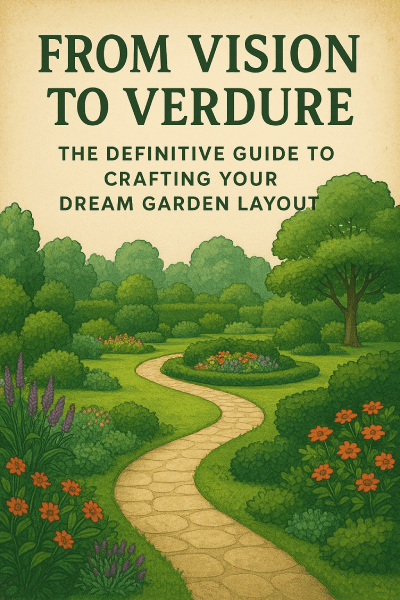From Vision to Verdure: The Definitive Guide to Crafting Your Dream Garden Layout
A garden is more than just plants. It’s like an extra room for your home—a place to relax, have fun or grow food. Making a great garden takes planning not luck. Whether you’re starting fresh or fixing up an old garden this guide will help you turn your ideas into a real thriving space. For more home inspiration, check out Leatheling’s Blog.
Section 1: The Blueprint Phase Vision & Assessment
Before you buy plants or dig dirt you need to know your space inside out. This step makes sure your garden is pretty, works well and fits your life.
1.1 Dreaming Big: Defining Your Garden’s Soul
First think about what you want your garden to be. Its purpose will guide every choice you make.
- The Social Hub: Want to host barbecues or parties? Plan a big patio for tables and chairs.
- The Quiet Retreat: Need a calm spot to relax? Add a bench, a small fountain and peaceful plants.
- The Edible Landscape: Love fresh food? Make space for veggie beds and fruit trees near your kitchen.
- The Pet-Friendly Zone: Got pets? Create a simple lawn that’s easy to clean and safe for them to play.
Next, pick a style to make everything look connected:
- Formal: Straight lines, neat hedges, and balanced shapes, like a fancy palace garden.
- Cottage: Curvy paths, colorful flowers, and a cozy, full look.
- Modern/Minimalist: Simple designs, clean lines and fewer plants with bold materials.
- Japanese Zen: Calm and balanced with rocks, sand and a few carefully placed plants.
- Wildlife-Friendly: Native plants and flowers to attract bees and birds.

For more on creating pet-friendly spaces, visit Leatheling’s Pet-Friendly Home Guide.
1.2 The All-Important Site Analysis
A quick sketch isn’t enough. To make a great garden, study your space carefully:
- Sun Mapping: Watch your garden all day. Draw a map and mark sunny spots, shady spots and areas with some sun. Check again in different seasons because the sun moves.
- Soil Health Deep Dive: Your soil keeps plants alive. Use a DIY pH test kit to check if it’s acidic or alkaline. Dig a hole, fill it with water and see how fast it drains to test water flow.
- Microclimates & Obstacles: Find warm or cool spots and windy areas. Note things like utility boxes or an ugly neighbor’s shed. Decide if you want to hide these with plants or screens.

For more on soil testing, check outsoil testing.
Section 2: The Core Design Principles – Structure & Flow
Now that you have a plan, build the “bones” of your garden. These are the parts that give it shape and guide how it feels.
2.1 Zoning: Creating Outdoor “Rooms”
Think of your garden like a house with different areas for different uses:
- Entry Zone: The path to your door should feel welcoming with planters or tidy flower beds.
- Public Zone: A patio or open area for gatherings, close to the house for easy access.
- Private Zone: A quiet spot for relaxing, maybe hidden behind a big shrub.
- Productive Zone: Veggie or herb gardens, placed in a sunny spot near the kitchen.
- Utility Zone: A hidden spot for compost bins or clotheslines.
- Transitional Zones: Paths or flower beds that connect everything smoothly.
2.2 Pathways & Circulation: Guiding the Eye & Foot
Paths are like the roads of your garden. They show where to walk and make it fun to explore.
- Functional vs. Aesthetic: Straight paths are quick and lead directly to places like a shed. Curved paths feel relaxed and make the garden seem bigger by hiding what’s next.
- Material Selection: Gravel is cheap but can move around. Stone pavers are strong and last long but cost more.
- Width & Edging: Paths should be wide enough for two people to walk together. Use metal or stone edging to keep them neat.
2.3 Establishing Focal Points & Views
A good garden has something special that grabs your attention:
- What to Use: A cool statue, a unique tree or a bright pot can be a focal point.
- Creating Vistas: Use a path or row of plants to point your eyes toward something pretty, like a bench in the distance.
- Screening Unwanted Views: Hide ugly views with tall hedges, a trellis with vines, or a decorative screen.
2.4 The Art of Repetition, Scale & Balance
These ideas make your garden look amazing:
- Repetition: Use the same plants or materials in different spots to tie the garden together.
- Scale: Make sure plants and features match the size of your garden and house.
- Balance: A formal garden is symmetrical, like a mirror. A casual garden can be uneven but still feel balanced.
Section 3: Bringing it to Life – Softscaping, Hardscaping & Beyond
Now it’s time to add the fun stuff—plants, structures, and extra touches.
3.1 Hardscaping: The Bones of Your Garden
Hardscaping is the non-living parts that give your garden structure:
- Patios & Decks: Patios are tough and great for outdoor “rooms.” Decks feel softer and warmer.
- Walls & Retaining Walls: Use these to level sloped areas or mark off spaces.
- Pergolas & Arbors: These add height and look great with climbing plants.
For more on hardscaping materials, see hardscaping.
3.2 Softscaping: The Heart of the Garden
Softscaping is all the growing things. Plan for variety and beauty all year:
- Planting Layers:
- Canopy Layer: Big trees for shade and size.
- Understory Layer: Small trees or big shrubs under the canopy.
- Shrub Layer: Medium shrubs for structure.
- Perennial Layer: Flowers and grasses that return yearly.
- Groundcover Layer: Low plants to cover soil and stop weeds.
- Color Theory: Use warm colors (red, orange) to stand out and cool colors (blue, green) to calm things down.
- Seasonal Interest: Pick plants that bloom in spring, summer, or have cool bark or berries in winter.
3.3 Water Features & Lighting
These add magic to your garden:
- Water’s Role: A birdbath or pond adds sound and attracts animals.
- Strategic Lighting: Lights let you enjoy your garden at night. Use them on paths or to highlight trees.
FAQs
What’s the best way to incorporate edible plants without looking messy?
Use raised beds with clean shapes to keep veggies tidy. Mix herbs with flowers for a neat look.
How do I work with an awkward-shaped garden?
Odd shapes are fun! Use curved paths to soften corners or tall plants to make the space feel even.
Should I hire a professional designer?
For big projects with slopes or drainage issues, a pro can save time and money.
How can I ensure my garden is eco-friendly?
Choose native plants that need less water and help local wildlife. Use gravel or permeable pavers to let water soak in.
What are some tips for designing on a budget?
Start with key features like paths or big plants. Add smaller items slowly over time.
Conclusion
Designing your garden is a rewarding journey that combines practicality with personal expression. The most successful garden isn’t necessarily the most costly one but the one that fits your lifestyle and reflects your unique vision. Be patient, enjoy the process and watch your dream garden take root and flourish.


